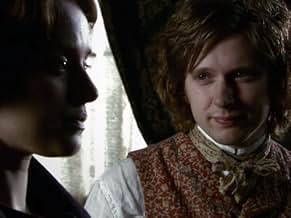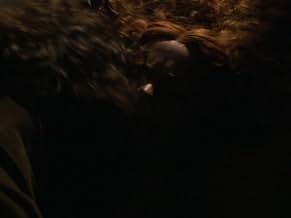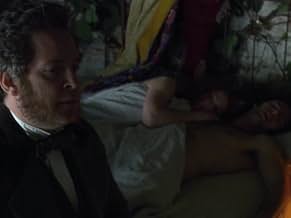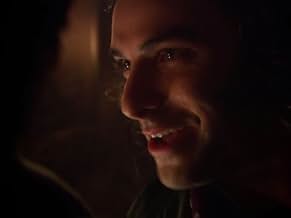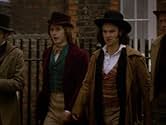Desperate Romantics
- Mini-série télévisée
- 2009
- 1h
NOTE IMDb
7,4/10
2,1 k
MA NOTE
Ajouter une intrigue dans votre languePeriod drama set in London about the rise of the Pre-Raphaelite Brotherhood.Period drama set in London about the rise of the Pre-Raphaelite Brotherhood.Period drama set in London about the rise of the Pre-Raphaelite Brotherhood.
- Nomination aux 2 BAFTA Awards
- 4 nominations au total
Parcourir les épisodes
Avis à la une
Anybody watching the series expecting a realistic portrayal of the lives of the Pre-Raphaelite Brotherhood will be disappointed however those just wanting an enjoyable romp with a good story that is well acted then this is just the thing. The characters were delightfully over the top without coming over as parodies.
The story follows the lives of artists Millais, Rossetti and Hunt along with their fictional friend Fred Walters as they recruit models Lizzie Siddal and Annie Miller and fall in love with them. The other main character is John Ruskin who supports their work.
While we do see some of their art the series was far more interested in their romantic entanglements which means there many sex scenes which means a fair amount of nudity... no strategically positioned sheets here. Another main theme is their quest to gain a patron who will enable them to become established.
From the moment it starts it is clear that this is going to be a romp as the music is as over the top that the story it goes with. Some people might not like this but I found it very jolly and suited to the story. The acting was fine throughout, I especially liked Amy Manson and Jennie Jacques's performances as Lizzie and Annie, I can see why the men in the story were besotted by their characters.
The story follows the lives of artists Millais, Rossetti and Hunt along with their fictional friend Fred Walters as they recruit models Lizzie Siddal and Annie Miller and fall in love with them. The other main character is John Ruskin who supports their work.
While we do see some of their art the series was far more interested in their romantic entanglements which means there many sex scenes which means a fair amount of nudity... no strategically positioned sheets here. Another main theme is their quest to gain a patron who will enable them to become established.
From the moment it starts it is clear that this is going to be a romp as the music is as over the top that the story it goes with. Some people might not like this but I found it very jolly and suited to the story. The acting was fine throughout, I especially liked Amy Manson and Jennie Jacques's performances as Lizzie and Annie, I can see why the men in the story were besotted by their characters.
Franny Moyle's book "Desperate Romantics", subtitled "The Private Lives of the Pre-Raphaelites", deals less with the art of the Pre-Raphaelite Brotherhood than it does with their changing relationships with one another and their relationships with women. Although it is fairly racy in its style, it is nevertheless a work of non-fiction, so Moyle was obliged to stick to historical fact. Peter Bowker's television series, however, although it is based upon Moyle's book, is heavily fictionalised. It concentrates upon the three main members of the Brotherhood, William Holman Hunt, John Everett Millais and Dante Gabriel Rossetti, their associates John Ruskin and William Morris, and the women in their lives. Edward Burne-Jones appears as a relatively minor character, but Ford Madox Brown is omitted altogether.
The main female characters are Ruskin's wife Effie, who later married Millais after a sensational divorce, Rossetti's muse, mistress and later wife Elizabeth Siddall, Hunt's muse, mistress and later fiancée (whom he never married) Annie Miller, Fanny Cornforth, another of Rossetti's models who also became his mistress, and Jane Burden, who married Morris but had an affair with Rossetti, by then a widower. Hunt's model and later wife Fanny Waugh is omitted, as are her sister Edith (whom Hunt married after Fanny's death) and Burne-Jones's model and mistress Maria Zambaco. Ruskin's curious relationship with the teenage Rose la Touche is dealt with in much less depth than it is in Moyle's book. (Perhaps Bowker, although otherwise happy to deal with his subjects' sex lives in some detail, was less happy to explore the controversial possibility that Ruskin may have been a paedophile).
Some of the series' departures from historical fact are relatively minor; the model for Holman Hunt's "The Hireling Shepherd" was not Miller but Emma Watkins. In a scene set in the 1850s we see Millais's notoriously sentimental "Bubbles" which was not painted until 1886. William Morris was quite a small man, not the tall figure depicted here. Others are more fundamental, the most important perhaps being the invention of Fred Walters, an imaginary member of the Pre-Raphaelite Brotherhood, although partly based upon the real-life Frederic Stephens. Like Stephens, Fred is a critic and journalist who uses his position to promote the work of the PRB, but he is also depicted as an innocent, idealistic young man, forever falling in love with women, particularly Elizabeth and Annie, who refuse to return his affections. (Annie's analysis is that Fred is "too nice" and that women like a man with something of the rogue about him). Bowker sometimes also follows Moyle into controversial conclusions which are not universally accepted; not all biographers, for example, would agree with her that Elizabeth Siddall's death was a suicide or that Annie Miller and Fanny Cornforth were prostitutes.
The acting is generally of a reasonable standard, the best performances in my view coming from Rafe Spall as Holman Hunt, a man torn between his artistic idealism and his genuine religious beliefs on the one hand and his fiery temper and the earthy, carnal side of his nature on the other, and Amy Manson as Lizzie. Lizzie is sometimes wrongly portrayed as a weak, passive figure, but Amy shows that she was a strong, determined young woman with artistic ambitions of her own. I was less impressed by a pre-Poldark Aidan Turner as Rossetti, played here as a man as carnal as Hunt, if not more so, but lacking Hunt's drive and work ethic, content to idle away his days without doing any significant work and forever depending upon his friends for "tin" (as he called money). Samuel Barnett's Millais contrasts oddly with his two painter colleagues; he emerges as a young man just as innocent as Fred, but with the difference that Effie returns his affections in full.
The series did not always find favour with the critics, although their criticisms tended to concentrate on its historical inaccuracies or on its failure to explain the philosophy of Pre-Raphaelitism or how the movement contrasted with the sort of art which had preceded it. Others took exception to the frequent and explicit sex scenes or to the jarring modern-style music. There is certainly some merit in such criticisms, and yet I couldn't help feeling that if you were looking for a fictional series about a group of free-thinking, free-living and free-loving nineteenth century artists, "Desperate Romantics" is actually quite a good one. 6/10.
The main female characters are Ruskin's wife Effie, who later married Millais after a sensational divorce, Rossetti's muse, mistress and later wife Elizabeth Siddall, Hunt's muse, mistress and later fiancée (whom he never married) Annie Miller, Fanny Cornforth, another of Rossetti's models who also became his mistress, and Jane Burden, who married Morris but had an affair with Rossetti, by then a widower. Hunt's model and later wife Fanny Waugh is omitted, as are her sister Edith (whom Hunt married after Fanny's death) and Burne-Jones's model and mistress Maria Zambaco. Ruskin's curious relationship with the teenage Rose la Touche is dealt with in much less depth than it is in Moyle's book. (Perhaps Bowker, although otherwise happy to deal with his subjects' sex lives in some detail, was less happy to explore the controversial possibility that Ruskin may have been a paedophile).
Some of the series' departures from historical fact are relatively minor; the model for Holman Hunt's "The Hireling Shepherd" was not Miller but Emma Watkins. In a scene set in the 1850s we see Millais's notoriously sentimental "Bubbles" which was not painted until 1886. William Morris was quite a small man, not the tall figure depicted here. Others are more fundamental, the most important perhaps being the invention of Fred Walters, an imaginary member of the Pre-Raphaelite Brotherhood, although partly based upon the real-life Frederic Stephens. Like Stephens, Fred is a critic and journalist who uses his position to promote the work of the PRB, but he is also depicted as an innocent, idealistic young man, forever falling in love with women, particularly Elizabeth and Annie, who refuse to return his affections. (Annie's analysis is that Fred is "too nice" and that women like a man with something of the rogue about him). Bowker sometimes also follows Moyle into controversial conclusions which are not universally accepted; not all biographers, for example, would agree with her that Elizabeth Siddall's death was a suicide or that Annie Miller and Fanny Cornforth were prostitutes.
The acting is generally of a reasonable standard, the best performances in my view coming from Rafe Spall as Holman Hunt, a man torn between his artistic idealism and his genuine religious beliefs on the one hand and his fiery temper and the earthy, carnal side of his nature on the other, and Amy Manson as Lizzie. Lizzie is sometimes wrongly portrayed as a weak, passive figure, but Amy shows that she was a strong, determined young woman with artistic ambitions of her own. I was less impressed by a pre-Poldark Aidan Turner as Rossetti, played here as a man as carnal as Hunt, if not more so, but lacking Hunt's drive and work ethic, content to idle away his days without doing any significant work and forever depending upon his friends for "tin" (as he called money). Samuel Barnett's Millais contrasts oddly with his two painter colleagues; he emerges as a young man just as innocent as Fred, but with the difference that Effie returns his affections in full.
The series did not always find favour with the critics, although their criticisms tended to concentrate on its historical inaccuracies or on its failure to explain the philosophy of Pre-Raphaelitism or how the movement contrasted with the sort of art which had preceded it. Others took exception to the frequent and explicit sex scenes or to the jarring modern-style music. There is certainly some merit in such criticisms, and yet I couldn't help feeling that if you were looking for a fictional series about a group of free-thinking, free-living and free-loving nineteenth century artists, "Desperate Romantics" is actually quite a good one. 6/10.
Some reviewers are taking things way too seriously. This is a fun, bawdy take on the life and loves of the Pre-Raphaelites. It's certainly not meant to be a piece of art scholarship. You see, there's this genre called historical FICTION. I almost turned it off in the first few minutes because I thought it going to cheesy but am so glad I didn't. It's funny, fast moving, well written, well acted, and infinitely watchable. But why oh why only one season??
Quite by accident, I stumbled upon Desperate Romantics while looking for something else. It has led me on a journey to learn more of the PRB artists, with whom I was totally unfamiliar. The portrayals of Millais, Hunt and Rosetti, their lives and loves is touching, funny and illuminating, in terms of their struggles for fame and recognition. The Fred Walters character keeps it all together. The casting in DR is perfect. Peter Bowker's writing is great and provides so much humor, along with the more serious struggles. Aidan Turner's reaction to his first sexual encounter with Fannie, a prostitute, is priceless and makes me laugh just thinking of it. Jennie Jacques, in only her second role was perfect as Annie Miller. She clearly showed the dilemma young women faced during this time and her struggle to obtain a better life, if not with Hunt, then with another. Amy Manson, as the beautiful model, Lizzie Siddall, is wonderful in showing sweetness, strength, vulnerability and despair because of her love for Rosetti. Others will point out this is not historically accurate and I'm sure they're right, but I looked at it as pure entertainment, realistic fiction. Daniel Pemberton's music is a delight in setting the mood so well. This is not a series for young children given the amount of nudity, but, if you're looking for a story that will give you strong characters and many laughs, this is a great choice.
Yes, well it may not be completely accurate and the writers may have taken certain liberties with the characters and the timelines, but I thoroughly enjoyed this show. It's a fast, funny, witty, sexy romp which doesn't take itself too seriously. The chemistry between the leads is palpable, as is the fact that everyone seems to be having a really good time playing some very interesting characters. I've watched it about three times now over the years and have enjoyed it every time. It's also made me curious to read up more about the PRB and their work. The actual PRB and their circle were, in many ways, extraordinary and occasionally over the top, and their lives were pretty fantastical, so this version really isn't much a stretch - I rather think they would have appreciated the 'inventive spirit' of the show's creators in bringing a contemporary interpretation of their story to the screen, as mentioned in the introduction / disclaimer at the beginning. If you want a staid art history docu-drama, this may not be for you. But if you want a fun, well made, entertaining, modern interpretation of a particular time and place and a group of people whose lives were, at times, stranger than fiction, go for it.
Le saviez-vous
- ConnexionsFeatured in The Big Fat Quiz of the Year (2010)
Meilleurs choix
Connectez-vous pour évaluer et suivre la liste de favoris afin de recevoir des recommandations personnalisées
- How many seasons does Desperate Romantics have?Alimenté par Alexa
Détails
- Date de sortie
- Pays d’origine
- Langue
- Aussi connu sous le nom de
- Desesperadamente románticos
- Lieux de tournage
- Société de production
- Voir plus de crédits d'entreprise sur IMDbPro
- Durée1 heure
- Couleur
Contribuer à cette page
Suggérer une modification ou ajouter du contenu manquant

Lacune principale
By what name was Desperate Romantics (2009) officially released in India in English?
Répondre


